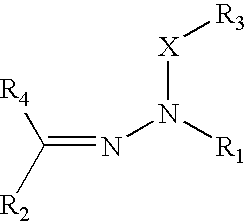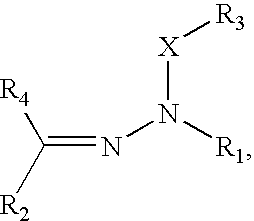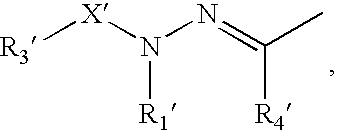Organophotoreceptor with a charge transport compound having an epoxy group
a charge transport compound and organophotoreceptor technology, applied in the field of organophotoreceptors, can solve the problems of affecting the performance of the organophotoreceptor, affecting the formation of the photoconductive element, and the addition of the liquid electrophotography problem, so as to achieve good mechanical and electrostatic properties, high quality of the imaging system, and high quality of images.
- Summary
- Abstract
- Description
- Claims
- Application Information
AI Technical Summary
Benefits of technology
Problems solved by technology
Method used
Image
Examples
example 1
Preparation of Charge Transfer Compounds
[0136]This example describes the synthesis of three charge transfer compounds described above. Specifically, the synthesis of Compounds (2), (4), (6), (9), and (12) corresponding to the formulas above is described.
Preparation of Compound (2)
[0137]Phenylhydrazine (0.1 mole, commercially available from Aldrich, Milwaukee, Wis.) and 4-(Diphenylamino)benzaldehyde (0.1 mole, available from Fluka, Buchs SG, Switzerland) were dissolved in 100 ml of isopropanol in a 250 ml 3-neck round bottom flask equipped with a reflux condenser and a mechanical stirrer. The solution was refluxed for 2 hours. Thin layer chromatography indicated the disappearance of the starting materials. At the end of the reaction, the mixture was cooled to room temperature. The 4-(diphenylamino)benzaldehyde phenylhydrazone crystals that formed upon standing were filtered off and washed with isopropanol and dried in a vacuum oven at 50° C. for 6 hours.
[0138]A mixture of 4-(diphenyl...
example 2
Preparation of an Electron Transport Compound
[0152]This example describes the preparation of (4-n-butoxycarbonyl-9-fluorenylidene) malononitrile.
[0153]A 460 g quantity of concentrated sulfuric acid (4.7 moles, analytical grade, commercially obtained from Sigma-Aldrich, Milwaukee, Wis.) and 100 g of diphenic acid (0.41 mole, commercially obtained from Acros Fisher Scientific Company Inc., Hanover Park, Ill.) were added to a 1-liter 3-neck round bottom flask, equipped with a thermometer, a mechanical stirrer and a reflux condenser. Using a heating mantle, the flask was heated to 135–145° C. for 12 minutes, and then cooled to room temperature. After cooling to room temperature, the solution was added to a 4-liter Erlenmeyer flask containing 3 liter of water. The mixture was stirred mechanically and was boiled gently for one hour. A yellow solid was filtered out hot, washed with hot water until the pH of the wash-water was neutral, and dried in the air overnight. The yellow solid was fl...
example 3
Forming Organophotoreceptors
[0156]This example described the characterization of Compounds (2), (6), (9), and (12), as described in Example 1 above. The characterization involves chemical characterization, while the electronic characterization of materials formed with the compound are described in subsequent examples.
Sample 1
[0157]Sample 1 was a single layer organophotoreceptor having a 76.2 micron (3 mil) thick polyester substrate with a layer of vapor-coated aluminum (commercially obtained from CP Films, Martinsville, Va.). The coating solution for the single layer organophotoreceptor was prepared by combining 1.87 g of Compound (2), 0.54 g of a (4-n-butoxycarbonyl-9-fluorenylidene) malononitrile, and 9.37 g of tetrahydrofuran, which were shaken until the all components were dissolved. A 7.4 g quantity of a 14 wt % polyvinyl butyral resin (BX-1, commercially obtained from Sekisui Chemical Co. Ltd., Japan) in tetrahydrofuran pre-mix solution and 0.83 g of a CGM mill-base containing...
PUM
| Property | Measurement | Unit |
|---|---|---|
| thickness | aaaaa | aaaaa |
| thickness | aaaaa | aaaaa |
| thickness | aaaaa | aaaaa |
Abstract
Description
Claims
Application Information
 Login to View More
Login to View More - R&D
- Intellectual Property
- Life Sciences
- Materials
- Tech Scout
- Unparalleled Data Quality
- Higher Quality Content
- 60% Fewer Hallucinations
Browse by: Latest US Patents, China's latest patents, Technical Efficacy Thesaurus, Application Domain, Technology Topic, Popular Technical Reports.
© 2025 PatSnap. All rights reserved.Legal|Privacy policy|Modern Slavery Act Transparency Statement|Sitemap|About US| Contact US: help@patsnap.com



